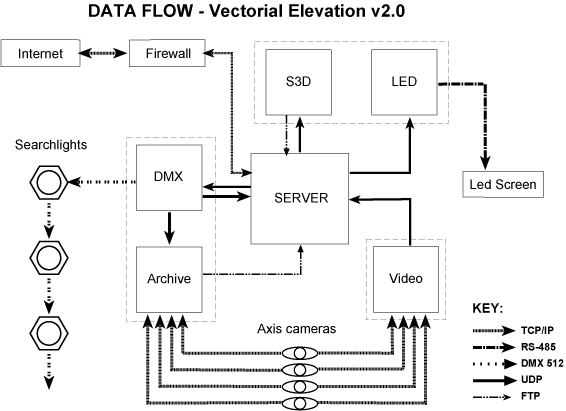| Vectorial Elevation Technology | |||||
| RA 4 | |||||
| Vectorial Elevation consists of a network of computers that process user requests on a first-come first-serve basis. Here are the different technologies involved: The user reaches www.alzado.net via a fixed IP address from Telefónica, our telecom partner and sponsor. They installed a 10Mbps ATM internet connection in the control room at the Artium Museum as well as two private lines to webcams located around the city. The web server is a Linux/Apache box behind a firewall. The server runs a queue programmed in perl and shell, serves pages and applets, relays video and sends emails to participants. To make a design, the user downloads a Java applet that contains Shout3D code from Eyematic Interfaces in California. Shout3D allows for real time 3D visualization of vrml files without the need for browser plug-ins in the vast majority of platforms. Eyematic kindly donated a software license for their product for the project website. The virtual world was modelled by Arquimedia in Madrid. When the participant submits a request the applet sends the exact x, y and z coordinates of each of the 18 virtual searchlights, as well as user information such as name, location and comments. The server queues this request. When a request reaches the head of the queue, the data is sent to a 3D DMX application written by APR inc. in Canada. This application knows the exact 3D position of each searchlight thanks to a calibration performed with differential GPS units and traditional surveying. The DMX application sends appropriate DMX commands over serial cable to the 18 Syncrolite SX7K searchlights to direct them to the desired location. The SX7Ks are new-generation 7kW xenon robotic fixtures that produce a very collimated lightbeam. When the searchlights produce the participant's design four Axis webcams, provided in part by Azlan in Madrid, take digital pictures from the Santa Maria Cathedral, the Bilbaina Hotel, and two Artium buildings. The images are watermarked with the participant's information using a custom-made application. As soon as the pictures are taken, a web page is built for the participant and an email is sent to him or her with its URL. A user may view his or her web page by entering the personal code or by typing the URL in a web browser. The personal page contains the real and virtual images of the user's design as well as their name, location, date, time and comments. A Java applet allows visitors to see the four project cameras in real time and shows an annotated aerial view of the city. |
|||||
 |
|||||
|
|
|||||